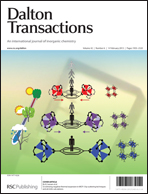Paramagnetic 3d coordination complexes involving redox-active tetrathiafulvalene derivatives: an efficient approach to elaborate multi-properties materials
Abstract
The elaboration of multifunctional materials is a great challenge for the physical chemistry community and the studies of molecular materials exhibiting coexistence or synergy between two or more properties are very active. In particular, molecular compounds displaying electrical conductivity and magnetic interactions are currently the subject of intensive studies. Two approaches are now well-known and are explored. On the one hand, the interactions between mobile electrons of the organic network (π electrons) and localized electrons of paramagnetic transition metal (d electrons) take place through space. On the other hand, these interactions take place through covalent chemical bonds. In the latter, the probability to have significant interaction between π and d electrons is enhanced compared to the first approach. In this perspective article, we will give an overview of the known coordination complexes involving tetrathiafulvalene derivatives as


 Please wait while we load your content...
Please wait while we load your content...